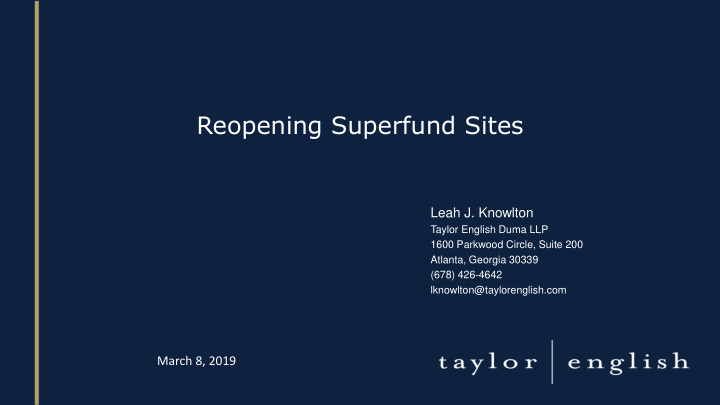



Reopening Superfund Sites Leah J. Knowlton Taylor English Duma LLP 1600 Parkwood Circle, Suite 200 Atlanta, Georgia 30339 (678) 426-4642 lknowlton@taylorenglish.com March 8, 2019
2 Causes of Reopening I. Remedy Not Effective or Site Vandalized II. New Contaminants or Exposure Pathways A. Vapor intrusion – now a component of HRS B. New or emerging contaminants • Example: PFOS-PFOAs, 1,4 Dioxane C. Remediation goals (PRGs) are lowered • Example: Dioxin cancer risk - based on 1995 science – is being reassessed. D. Engineering controls change or fail. III. Change in Land Use A. Site cleaned up to commercial/industrial is redeveloped to residential. IV. Change in Administration
South Dayton Dump and Landfill Site 3 3
4 Reopening Defined When in the Superfund process can we say a Site is “reopened”? • Deleted from NPL? o Only 413 Sites ever removed from NPL, as of 02/05/2019.* • Remedy Selection? • Significant changes ordered in a new ASAOC? * https://www.epa.gov/superfund/superfund-national-priorities-list-npl
5 Examples • After a 17-year, PRP-led remedial investigation process, at a cost exceeding $110 million, EPA Region 10 issued a Record of Decision (ROD) in the closing hours of the Obama Administration. The ROD itself recognized that the baseline data upon which Region 10 relied in selecting its preferred remedy had grown stale, and called for another site-wide round of sampling prior to any Remedial Design for specific facilities. From <http://www.acoel.org/post/2017/10/18/EPA-Beginning-Anew-at-Portland-Harbor-Superfund-Site.aspx> • We had a site that was deemed closed in 1999 under the Massachusetts Contingency Plan and then was reopened in 2010. In that case, because of VI, we needed to get back into a site that we no longer owned or had any contractual right to enter. We ended up needing to sample in homes related to the site in a community that our client had not been part of for more than 10 years. So, the "closed" status of a site is something that generally means that there is less risk of the site coming back and needing to be addressed, but your client should know that a site that it considers closed may not stay [*10011] closed or should not continue to be considered closed for planning or decision making purposes. From Vapor Intrusion: The State of the Science and the Law, 43 ELR 10005, 10010-10011 5
6 Difficult Questions • What happens if a remedy is disturbed, e.g. a capped site dug up, and another removal or remedial action occurs? • Can there be more than one cost recovery suit for removal costs at the same site? • What if a previously remediated site is reopened to address a new remedial standard, after prior cost recovery actions? • If initiation of construction of a remedy triggers the SoL, what if a new area of contamination is found after the SoL expires? • Can each OU be the basis for different suits for response costs if work described in the ACOs overlaps? • Can there be more than one “facility” at a site, and thus more than one action for response costs? • Can you seek § 113 contribution for costs that were not connected with the same trigger of that § 113 action?
7 Contact Me If You Have Questions! Leah J. Knowlton Taylor English Duma LLP 1600 Parkwood Circle, Suite 200 Atlanta, Georgia 30339 (678) 426-4642 lknowlton@taylorenglish.com 7
8 Vail T. Thorne Taylor English Duma LLP 1600 Parkwood Circle, Suite 200 Atlanta, Georgia 30339 (678) 426-4612 vthorne@taylorenglish.com
Recommend
More recommend